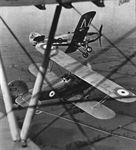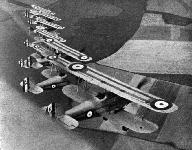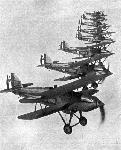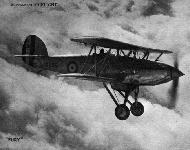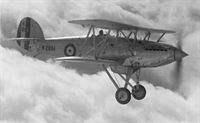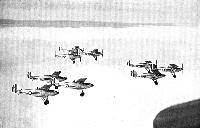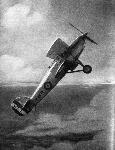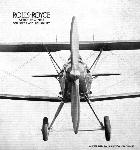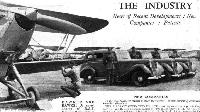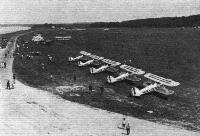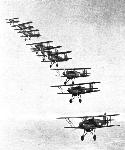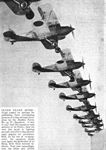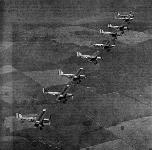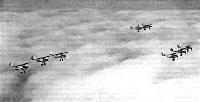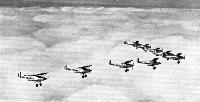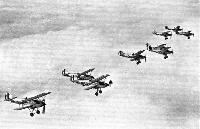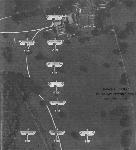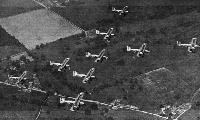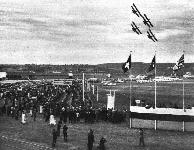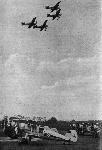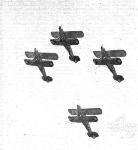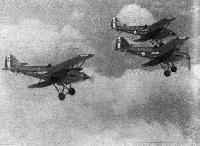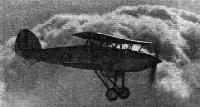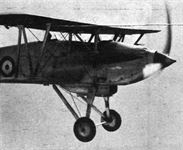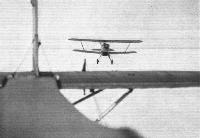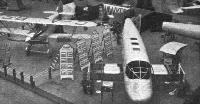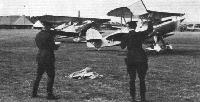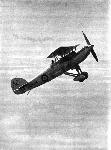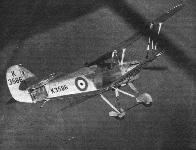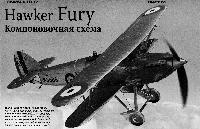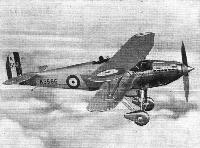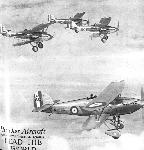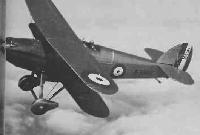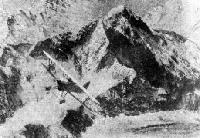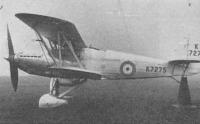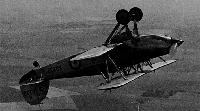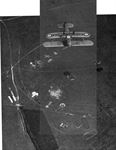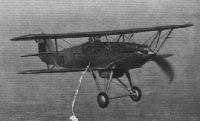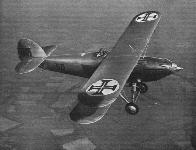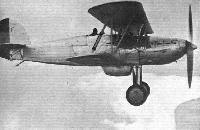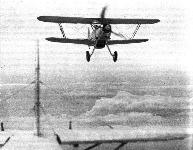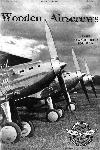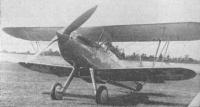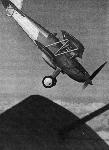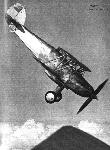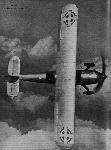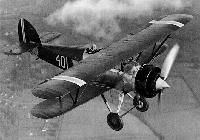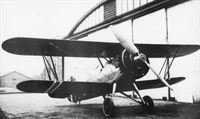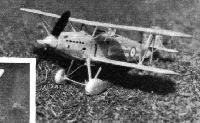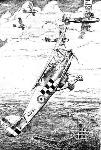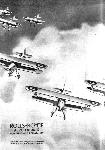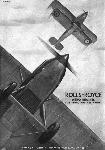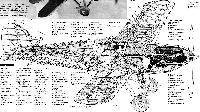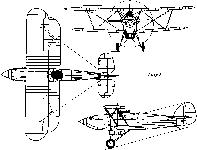
Варианты
- Hawker - Hornet / F.20/27 - 1928 - Великобритания
- Hawker - Fury - 1931 - Великобритания
- Hawker - Nimrod - 1931 - Великобритания
- Hawker - PV.3 - 1934 - Великобритания
- Isaacs - Fury - 1963 - Великобритания
Fury
Цельнометаллический одноместный биплан с открытой кабиной и неубирающимся шасси. Спроектирован в КБ фирмы "Хаукер эйркрафт" под руководством С. Кэмма. Первый полет опытный образец "Фьюри" совершил 25 марта 1931 г. Выпускался серийно с апреля 1931 г. заводами фирм "Хаукер" и "Дженерал эйркрафт" в Англии, а также по лицензии в Югославии (заводы "Икарус" в Белграде и "Змай" в Земуне). Всего построено 300 экз. всех модификаций. Самолет состоял на вооружении в Великобритании - с мая 1931 г., в Югославии - с июня 1932 г., в Иране - с 1933 г., а также в ЮАС. Вооружение 2x7,69.
Основные серийные модификации:
- "Фьюри" I с мотором "Кестрел" VS;
- "Фьюри" II с мотором "Кестрел" VI и обтекателями на колесах;
- экспортная для Ирана на базе "Фьюри" I, но с мотором "Меркьюри" VIS2 и увеличенным вертикальным оперением;
- экспортная для Ирана с мотором "Хорнет" S2B-1G;
- "Фьюри" IA - экспортная для Югославии на базе "Фьюри" I, но с обтекателями колес;
- "Фьюри" II югославской постройки с мотором "Кестрел" XVI, свободнонесущими стойками шасси, увеличенным радиатором, дополнительным бензобаком.
Участвовал в боевых действиях в Испании в 1937 г. В Великобритании снят с вооружения в 1939 г., но южноафриканские части применяли "Фьюри" в Восточной Африке в 1940-1941 гг. против итальянцев. Югославские истребители принимали участие в отражении вторжения немцев в апреле 1941 г. и были практически полностью уничтожены. В Иране "Фьюри" состояли на вооружении до конца 1942 г.
"Фьюри" I||
Размах:||9,14 м
Длина:||8,13 м
Моторы, количество х мощность:||1x525 л.с.
Взлетная масса, максимальная:||1583 кг
Максимальная скорость:||333 км/ч
Практический потолок:||8535 м
Дальность:||490 км
Описание:
- Fury
- Hawker Fury I и II
- Flight, November 1932
British Aircraft - Flight, June 1934
NEW AND EXPERIMENTAL
Фотографии
-
Air Enthusiast 1971-09 / R.Braybrook - Biplane Era: The Flight from Reality /Fighters in the RAF/ (1)
Регистрационный номер: K2048 [6] Hawker Fury I of No 1 Squadron (1933).
-
Авиация и Время 1999-05 / А.Котлобовский, Е.Хавило - Элегантная "Фурия" /Домашний авиамузей/
Регистрационный номер: K2048 [6] Fury I командира 1-й АЭ ВВС Великобритании. Тангмере, 1937г.
-
Авиация и Время 1999-05 / А.Котлобовский, Е.Хавило - Элегантная "Фурия" /Домашний авиамузей/
Spanish Fury республиканской Испании. Осень 1936г.
-
Авиация и Время 1999-05 / А.Котлобовский, Е.Хавило - Элегантная "Фурия" /Домашний авиамузей/
Тот же самолет на службе ВВС франкистов, конец 30-х гг.
-
Авиация и Время 1999-05 / А.Котлобовский, Е.Хавило - Элегантная "Фурия" /Домашний авиамузей/
Jugoslav Fury 5-го авиаполка королевских ВВС Югославии, начало 1941г.
-
Мировая Авиация 152
Регистрационный номер: K7272 Этот самолет из британской 41-й эскадрильи ВВС входил в партию из 23 Hawker Fury Mk II, поставленных в октябре - декабре 1936 года. Обратите внимание на характерные обтекатели стоек шасси.
-
Авиация и Время 1999-05 / А.Котлобовский, Е.Хавило - Элегантная "Фурия" /Домашний авиамузей/
Persian (Mercury) Fury ВВС Ирана, конец 30-х гг.
-
Aeroplane Monthly 1998-12
Регистрационный номер: K1930 [8], OO-HFU [8], G-BKBB [8] Vintage Engine Technology Ltd is currently restoring the Rolls-Royce Kestrel engine of Hawker Fury replica “K1930”/OO-HFU (formerly G-BKBB) at Little Gransden. Built by the late Viv Bellamy, the aircraft is seen here with Tony Bianchi strapping himself in on the day of its CAA Permit acceptance flight on May 9, 1987.
-
Aeroplane Monthly 1991-12 / A.Lumsden - On silver wings (15)
Регистрационный номер: K1926 [6] A fine photograph of Hawker Fury I K1926, the first production aircraft from an initial RAF batch of 21 aircraft delivered in April 1931.
First production Hawker Fury K1926 was allocated to No 1 Sqn, Sammy Wroath's first squadron posting after Grantham.
Hawker Fury K1926 shows off its seductive lines. Its popularity with pilots was probably as great as that of the Spitfire with its pilots several years later. This Fury was tested by the A&AEE and the RAE before delivery to 1 Sqn. -
Flight 1932-11 / Flight
Регистрационный номер: K1926 [6] THE HAWKER "FURY": A single-seater interceptor fighter with Rolls-Royce Kestrel engine.
-
Aeroplane Monthly 1992-01 / J.Fozard - Camm's engine legacy
Регистрационный номер: K1926 [6] Camm's masterpiece, the Hawker Fury I. The type remained in first-line service from 1931 until 1939.
-
Aeroplane Monthly 1991-12 / A.Lumsden - On silver wings (15)
Регистрационный номер: K1926 [6] Hawker Fury I K1926 was the first production aircraft. After a period with the A&AEE and the RAE, it flew with 1 Sqn; it was finally grounded as instructional airframe 928M.
-
Aeroplane Monthly 1991-12 / A.Lumsden - On silver wings (15)
Регистрационный номер: K1927 [2] 25 марта 1931г.: первый полет в Брукленде, Суррей, под управлением флайт-лейтенанта П. У. С. Балмэна выполнил первый серийный истребитель Hawker Fury I (K1926). Он стал первым британским истребителем, превысившим в горизонтальном полете скорость 200 миль в час (322 км/ч). В мае 1931 года самолеты данного типа поступили на вооружение 43-й эскадрильи британских ВВС. На снимке - K1927, второй из трех предсерийных Fury I.
Two views of K1927, the second production Hawker Fury. This too first went to the A&AEE and then to the RAE, after which it joined 43 Sqn before ending up as 1068M in 1938. -
Air Pictorial 1957-11 / R.Cross - Fury Fighters
Регистрационный номер: K1927 [2] Fury I was second of three prototypes, K1926-7-8. First prototype flew in July 1930 with a 525-h.p. Kestrel IB, did 202 m.p.h. at 10,800 ft. Second and subsequent Fury Is had the 550-h.p. Kestrel IIS.
-
Flight 1938-05 / Flight
Регистрационный номер: K1929, K2071 A PAIR of Hawker Fury single-seater fighters of the Advanced Training Squadron, No. 3 Flying Training School, South Cerney, skating along on their sides in a “crazy formation” rehearsal for Empire Air Day.
-
Aeroplane Monthly 1992-01 / M.Oakey - Grapevine
Регистрационный номер: G-BKBB [8], K1930 [8], OO-HFU [8] After fading from sight since its acquisition by a Belgian Collector at Christie’s 1990 Duxford auction, Hawker Fury replica G-BKBB is back in one piece following an engine rebuild. It is seen here at Booker on November 28, 1991, having just had its Kestrel started by the Shuttleworth Collection’s Hucks Starter, borrowed especially for the occasion.
-
Aeroplane Monthly 1990-04
Регистрационный номер: G-BKBB [8], K1930 [8], OO-HFU [8] Hawker Fury Replica G-BKBB. Sir Sydney Camm designed the Fury as the first R.A.F. single seat fighter capable of sustaining speeds in excess of 200 mph. These aircraft were fitted with Rolls Royce Kestrel IIS engines, developing 525 HP at 14, This replica was constructed as near as practical to the original by Westward Airways Ltd. 1984-1988 and is finished in the colour scheme of No. 43 Squadron R.A.F. in 1931. It is fitted with a Rolls Royce Kestrel MK V engine.
-
Aeroplane Monthly 1985-07 / Grapevine
Регистрационный номер: G-BKBB [8], K1930 [8], OO-HFU [8] Hawker Fury replica G-BKBB/ K1930, being built at Lands End by Viv Bellamy, is nearing completion. Engine runs were imminent at time of press.
-
Aeroplane Monthly 1988-03
Регистрационный номер: G-BKBB [8], K1930 [8], OO-HFU [8] R.H.BROWN photographed the late Patrick Lindsay's Hawker Fury replica K1930 at its Penzance base in September 19??.
-
Aeroplane Monthly 1986-02 / Grapevine
Регистрационный номер: G-BKBB [8], K1930 [8], OO-HFU [8] The Fury, K1930/G-BKBB, is a reproduction built by Viv Bellamy at Land’s End Airfield in Cornwall, and powered by an original Rolls-Royce Kestrel engine.
-
Aeroplane Monthly 1987-03 / M.Oakey - Grapevine
Регистрационный номер: G-BKBB [8], K1930 [8], OO-HFU [8] The first flying shot we have seen of the late Patrick Lindsays Hawker Fury reproduction, K1930. The aircraft has been grounded for a year while its future is being decided.
-
Мировая Авиация 115
Регистрационный номер: K1937 Верхние крылья и фюзеляжи истребителей Fury из 43-й эскадрильи украшены черно-белыми шашечками, являвшимися отличительным знаком этого подразделения. 43-я эскадрилья летала на Fury до 1939 года.
-
Aeroplane Monthly 1992-01 / O.Thetford - On silver wings (16)
Регистрационный номер: K1934, K1938, K1942 Rolls-Royce "Kestrel VI" engines will be fitted to future "Furies" for the R.A.F. Here a flight of No. 43 (Fighter) Squadron, one of the three "Fury" units now in service, is seen landing in formation.
A trio of 43 Sqn Furies taking off from Brooklands. -
Flight 1931-06 / Flight
Регистрационный номер: K1943 THE "STAR TURN": The Hawker "Fury" (Rolls-Royce "Kestrel") was demonstrated in masterly fashion at Brooklands by Mr. Sayer, Hawker's Test Pilot.
-
Flight 1936-03 / Flight Advertisements
Регистрационный номер: K1944 [2] -
Aeroplane Monthly 1991-12 / A.Lumsden - On silver wings (15)
Регистрационный номер: K1944 [2] INTERCEPTING EXTRAORDINARY: Our Photographer has caught the Hawker "Fury" (Rolls-Royce "Kestrel" engine) high above the clouds as Mr. Bulman swung it up and out in an Immelmann Turn after "attacking" a Hawker "Horseley" piloted by Mr. Sayer.
An unusual view of Hawker Fury I K1944, from the same initial batch. After service with 43 Sqn it became an instructional airframe in June 1936. -
Aeroplane Monthly 1992-01 / O.Thetford - On silver wings (16)
Регистрационный номер: K2041, K2042 Истребители "Фьюри" 1 в полете, 1-я эскадрилья Королевских ВВС, июль 1933 г.
Classic Flight photograph of 1 Sqn Furies up from RAF Tangmere in July 1933. -
Aeroplane Monthly 1992-01 / O.Thetford - On silver wings (16)
Регистрационный номер: K2040, K2043 [2], K2881 [2], K5673 [2] Hawker Fury Is of 1 Squadron. Nearest the camera is K2043, delivered early in 1932 and relegated to an instructional airframe in November 1937. The other Furies are: K2040, which appears to have a replacement rudder; K5673, which has the squadron badge inside the standard spearhead surround on the fin (it crashed on landing at South Cerney on December 7, 1938 while with 3 FTS); and, furthest from the camera, K2881, which was delivered in December 1932.
-
Flight 1933-09 / Flight
ECHELON ON THE RIGHT, STEPPED UP: View of No. 1 (Fighter) Squadron in one of the most difficult of all formations.
-
Flight 1933-09 / Flight
Регистрационный номер: K2045 [3], K2048 [6], K2066 [2] No. 1 (FIGHTER) SQUADRON: The squadron marking is two red lines, parallel on the upper planes, but converging on the fuselage.
-
Мировая Авиация 115
Регистрационный номер: K2045 [3], K2048 [6], K2066 [2] Перевооружение первых трех эскадрилий с истребителей Siskin на Fury началось в мае 1931 года (эскадрилья № 43) и завершилось в феврале 1932 года (эскадрильи № 1 и №25). Эти машины 1-й эскадрильи показаны в цельносеребристой окраске (периода до 1934 года), с красно-бело-синими рулями направления.
-
Aeroplane Monthly 1991-12 / A.Lumsden - On silver wings (15)
Регистрационный номер: K2048 [6] THE CO.: Sqd. Ldr. C. B. S. Spackman, D.F.C., in his Hawker "Fury."
Hawker Fury I K2048, the squadron commander’s aircraft of No 1 Squadron, photographed in April 1933, up from RAF Tangmere. -
Flight 1938-05 / Flight
Регистрационный номер: K2048 [6] HAWKER FURY: Fighter (Kestrel V engine - 640 h.p. at 14,000ft.); span, 30ft.; gross weight, 3,609 lb.; max. speed, 223 m.p.h. at 16,400ft.
-
Aeroplane Monthly 1991-12 / A.Lumsden - On silver wings (15)
Регистрационный номер: K2051 [3] Hawker Fury I K2051 flew with Nos 1, 43 and 25 Sqns before becoming an instructional airframe in November 1937. K2051 was part of the second batch of 48 RAF aircraft, delivered between January and March 1932.
-
Flight 1935-05 / Flight
Регистрационный номер: K2051 [3] Hawker "Fury" (Rolls-Royce "Kestrel" II.S).
-
Air International 2020-03 / D.Unwin - Fighter Training Perils of RAF's Pioneer Pilots /Military/
Регистрационный номер: K2051 [3] The pilot of a 1917 SE5A would not have found a 1937 Hawker Fury a particularly intimidating prospect.
-
Flight 1935-06 / Flight Advertisements
Регистрационный номер: K2052 [5], K2054 [3] -
Flight 1932-12 / Flight
Регистрационный номер: K2052 [5] SQUADRON FORMATION: No. 25 (Fighter) Squadron flying their interceptor Hawker "Furies" (Rolls-Royce "Kestrels") above the clouds.
-
Flight 1933-12 / Flight Advertisements
Регистрационный номер: K2052 [5] No.25 (Fighter) Squadron RAF Hawker Furies' fitted with Rolls-Royce 'Kestrel' Engines.
-
Flight 1933-07 / Flight
Регистрационный номер: K2059 [2], K2074 [2] R.A.F.: The Hawker "Furies" of No. 25 Squadron lined up ready for their display.
-
Air Pictorial 1961-12 / J.Rawlings - 25 Squadron History
Регистрационный номер: K2062, K2070 Fury I (K2070) with 25 Squadron colours on the fuselage; No. 25's crest can be seen on the fin of the aircraft to the left
-
Aeroplane Monthly 1990-11 / Personal album. Military
Регистрационный номер: K2074 [2] Hawker Fury I K2074 taking part in the 1936 RAF Pageant Headquarters Race at Hendon on June 2. This race traditionally opened the Pageant programme each year and the competitors were RAF officers of various Commands. K2074 was first delivered to 1 Squadron and later passed to 43 Squadron at RAF Tangmere. On April 4, 1938 this Fury broke up in the air over Chichester.
-
Air Enthusiast 1971-09 / R.Braybrook - Biplane Era: The Flight from Reality /Fighters in the RAF/ (1)
Регистрационный номер: K2079 [2], K2882 [2], K2883 [2] The elegant Hawker Fury was one of the large family of biplanes originated on Sydney Canon's drawing boards in the inter-war periods. Seven RAF squadrons flew Furies, including No 25, illustrated performing a "tied-together" display.
-
Flight 1933-09 / Flight Advertisements
Регистрационный номер: K2874 A HAWKER "FURY" with "Kestrel" IIS Engine. The world's Fighter Supreme.
-
Aeroplane Monthly 1986-05 / Personal album
Регистрационный номер: K2876 [2] Hawker Fury I K2876 was delivered to the RAF in December 1932. Part of a batch often aircraft, K2876 entered service with 3 FTS and then passed to 6 FTS. In January 1940 the Fury became 1719M and presumably became an instructional airframe. Total production of the Fury I for the RAF amounted to 117 aircraft, built between 1930 and 1935. The type was allocated to Nos 1, 25 and 43 Squadrons and remained in first-line service until 1939.
-
Aeroplane Monthly 1986-05 / Personal album
Регистрационный номер: K2876 [2] -
Aeroplane Monthly 1974-09 / ??? - Hendon Pageantry 1920-37
Регистрационный номер: K2079 [2], K2882 [2], K2883 [2] HULLO TRIPLETS: A Flight of No. 25 (Fighter) Squadron come in to land with their connecting cords still unbroken.
A flight of 25 Sqn Furies land tied together at the 1934 RAF Display at Hendon on June 30. Three flights of three landed in this way, and all but one of the rubber cables remained unbroken. -
Air Pictorial 1977-07 / M.Bowyer - R.A.F. on Parade - the 1935 Jubilee Review
Регистрационный номер: K2901 Ever impressive were the Hawker Furies of No. 1 Squadron; K2901 in the foreground
-
Aeroplane Monthly 1992-01 / O.Thetford - On silver wings (16)
Регистрационный номер: K2902 The Hawker Fury is single-seater, an intercepter. The Fury mount the 600 h.p. Rolls-Royce Kestrel.
Fury 1 K2902 of 1 Sqn was delivered in January 1933. -
Aeroplane Monthly 1974-02 / R.King - The beautiful Blitz
Регистрационный номер: K3586 [19] An interesting formation comprising l. to r., Fairey Battle K7572, the He 70G, and Hawker Fury K3586 near Hucknall in September 1937.
Другие самолёты на фотографии: Fairey Battle - Великобритания - 1936Heinkel He-70/Не-170 Blitz - Германия - 1932
-
Aeroplane Monthly 1992-01 / O.Thetford - On silver wings (16)
Регистрационный номер: K2039, K2043 [2], K2881 [2], K5673 [2] Another view of the four 1 Sqn Furies.
-
Flight 1935-05 / Flight Advertisements
HAWKER FURY ROLLS-ROYCE KESTREL ENGINE
-
Aeroplane Monthly 1989-12 / K.Delve - Women in Air Force Blue
WAAF trainee mechanics starting up the Rolls-Royce Kestrel on a Hawker Fury.
-
Flight 1937-07 / Flight
HAWKER AND HAWKS: A smart line-up of R.A.F. Hillman Hawk service cars seen at the Hendon Display.
-
Aeroplane Monthly 1989-02 / Personal album. Military
Регистрационный номер: K2045 [3] A Hawker Fury I, almost certainly K2045 of 1 Sqn, pictured at Brooklands in 1933. Part of an RAF order for 48 Fury Is delivered in early 1932, K2045 crashed following a forced landing on December 15, 1936. No 1’s Furies were based at RAF Tangmere.
-
Flight 1934-01 / Flight
AT THE SCHOOLBOYS' EXHIBITION: One of the attractions was a Sopwith "Camel," used in the Great War, compared with a modern Hawker "Fury."
Другие самолёты на фотографии: Sopwith Camel / F.1 - Великобритания - 1916
-
Flight 1934-08 / Flight
FURIES IN CANADA: A line of aircraft which took part In the demonstration at Ottawa in July.
-
Aeroplane Monthly 1990-10 / J.Meadows - Flying for fun (5)
RAF Upavon aerodrome in June 1938 at the time when it abounded with Ansons, Oxfords, Harts, Tutors and Furies.
Другие самолёты на фотографии: Airspeed Oxford / AS.10 - Великобритания - 1937Avro Tutor/Sea Tutor/Prefect / Type 621/646/626 - Великобритания - 1929Hawker Hart - Великобритания - 1928
-
Flight 1932-02 / Flight
The photograph shows a line-up at Brooklands of Hawker "Furies" and (behind) "Harts."
Другие самолёты на фотографии: Hawker Hart - Великобритания - 1928
-
Flight 1933-09 / Flight
ECHELON ON THE RIGHT, STEPPED UP: View of No. 1 (Fighter) Squadron in one of the most difficult of all formations.
-
Flight 1938-11 / Flight
SEVEN YEARS AFTER: Flight makes no apology for publishing these outstanding pictures of a line-abreast formation by the Hawker Furies No. 43 (F.) Squadron. It was in 1931 that the squadron took delivery of its Furies, then the very last word in fighting aircraft, and still to-day exceedingly popular for aerobatics. Now, on the eve of re-equipment, the squadron shows once again the perfection of its flying with these beloved biplanes. Their new camouflage, with the white and yellow circles omitted, is of interest
-
Aeroplane Monthly 1991-05 / D.Edwards - Flights and frights in the thirties (3)
Hawker Furies of 43 Sqn up from RAF Tangmere in October 1938. The aircraft were camouflaged, with the white and yellow roundel circles omitted, for the duration of the Munich crisis. When war was declared in September 1939 around 50 Fury IIs were still in service.
Camouflaged 43 Sqn Furies up from RAF Tangmere in October 1938. From September 1938 all the squadron's Furies were painted thus, with squadron markings deleted for the duration of the Munich Crisis. -
Flight 1932-07 / Flight
IN LINE ABREAST: No. 43 (Fighter) Squadron in another of their formations.
-
Aeroplane Monthly 1982-10 / D.Middleton - A.E.Clouston /Test Pilot Profile/ (4)
Регистрационный номер: K2052 [5], K2054 [3] "SQUADRON LINE ABREAST": Perfect formation flying by No. 25 (Fighter) Squadron.
Hawker Furies of No 25 Fighter Squadron up from Hawkinge in November 1932. -
Flight 1932-12 / Flight
ACCURACY: No. 25 F.S. in squadron formation with nights in line abreast.
-
Flight 1933-09 / Flight
No. 1 (FIGHTER) SQUADRON: In the left-hand picture the squadron is in Squadron Formation; in the lower right-hand picture it is in Squadron V, and in the top right one of the flights is shown doing a "flight roll."
-
Flight 1932-12 / Flight
SQUADRON "V": No. 25 (Fighter) Squadron can fly their "Furies" in any formation.
-
Flight 1932-12 / Flight
Регистрационный номер: K2052 [5], K2054 [3] NO. 25 (FIGHTER) SQUADRON (HAWKER "FURIES" AND ROLLS-ROYCE "KESTRELS"): "Flights Line Abreast" above Hawkinge.
-
Flight 1933-09 / Flight
FLIGHTS LINE ABREAST: The clean lines of the Hawker "Furies" (Rolls-Royce "Kestrels") of No. I (Fighter) Squadron from Tangmere show up well in this effective formation.
-
Aeroplane Monthly 1992-01 / O.Thetford - On silver wings (16)
Three flights of 43 Sqn Furies up from RAF Tangmere in June 1932.
-
Aeroplane Monthly 1992-01 / O.Thetford - On silver wings (16)
Camouflaged 43 Sqn Furies up from RAF Tangmere in October 1938. From September 1938 all the squadron's Furies were painted thus, with squadron markings deleted for the duration of the Munich Crisis.
-
Flight 1933-09 / Flight
"1": No.1 (Fighter) Squadron do a little figure-writing, being naturally proud of their number.
-
Flight 1935-06 / Flight Advertisements
HAWKER "FURY" ROLLS-ROYCE "KESTREL" ENGINE
-
Flight 1932-07 / Flight
THE SIGN OF THE CROSS: Hawker "Furies" ("Kestrel") of No. 43 (Fighter) Squadron showing one of their ten formations.
-
Flight 1934-07 / Flight
"UNITED WE FLY": No. 25 (Fighter) Squadron on Hawker "Fury" (" Kestrel II.S") fly past "tied together." The connecting cords may be seen between the wing tips.
-
Flight 1937-08 / Flight
The four Hawker Furies in their famous diamond formation.
-
Flight 1937-08 / Flight
THE R.A.F. AT ZURICH. Four Furies of No. 1 Fighter Squadron give their R.A.F. Display demonstration over Dubendorf aerodrome.
-
Aeroplane Monthly 1988-10 / P.Cooksley - RAF Kenley. Bulwark of London (2)
The aerobatic Fury flight from No. 1 (F.) Squadron in action over the Gladiators of No. 3 (F.) Squadron.
A quartet of 1 Sqn Hawker Furies aerobat above 3 Sqn’s Gladiators at RAF Kenley in May 1937.Другие самолёты на фотографии: Gloster Gladiator - Великобритания - 1934
-
Flight 1937-08 / Flight Advertisements
A flight of HAWKER FURY single-seater fighters (Kestrel V engines) flying over a squadron of GLOSTER GLADIATORS (Bristol Mercury).
Другие самолёты на фотографии: Gloster Gladiator - Великобритания - 1934
-
Flight 1937-07 / Flight
Something new in flight aerobatics: Four Furies carry out combined aerobatics and formation changes. In this view the machines are seen in the basic diamond formation.
-
Flight 1934-06 / Flight
"Furies" ("Kestrel") of No. 43 (Fighter) Squadron.
-
Flight 1933-07 / Flight
ALL "KESTRELS": Three Hawker "Furies" of No. 1 (Fighter) Squadron, with "Kestrel" engines.
-
Flight 1935-06 / Flight
The "Fury" single seater is fitted with the 525 h.p. supercharged water-cooled "Kestrel."
-
Flight 1939-07 / Flight
The Rolls-Royce experimental section at Hucknall used the Hawker Fury for experiments with cooling systems.
-
Flight 1931-04 / Flight
THE INTERCEPTOR FIGHTER: A Photographic Impression of a Hawker "Fury" with Rolls Royce engine above the clouds.
-
Flight 1931-07 / Flight
THE "FURIES": THESE MACHINES OF NO. 43 (FIGHTER) SQUADRON COMING OUT OF A LOOP IN LINE ASTERN.
-
Aeroplane Monthly 1991-04 / D.Edwards - Flights and frights in the thirties (2)
Регистрационный номер: K1926 [6] The latest production type of Hawker "Fury" (Rolls-Royce "Kestrel" engine), the Interceptor Fighter ordered for No. 43 (Fighter) Squadron. This photograph was obtained above the clouds recently, from a Hawker "Horsley." The two machines were piloted by Mr. Bulman and Mr. Saver respectively.
Hawker Fury K1926 shows off its seductive lines. Its popularity with pilots was probably as great as that of the Spitfire with its pilots several years later. This Fury was tested by the A&AEE and the RAE before delivery to 1 Sqn.Другие самолёты на фотографии: Hawker Horsley / Dantorp - Великобритания - 1925
-
Flight 1931-04 / Flight
Регистрационный номер: K1926 [6] The latest production type of Hawker "Fury" (Rolls-Royce "Kestrel" engine), the Interceptor Fighter ordered for No. 43 (Fighter) Squadron. In the photograph it looks curiously as if the "Fury" was about to alight on the tail of H.M. Aircraft Carrier "Horsley." This photograph was obtained above the clouds recently, from a Hawker "Horsley." The two machines were piloted by Mr. Bulman and Mr. Saver respectively.
Другие самолёты на фотографии: Hawker Horsley / Dantorp - Великобритания - 1925
-
Flight 1936-01 / Flight
Регистрационный номер: K2059 [2] A SERVICE RECORD: Figures recently issued by the Air Ministry show that the flying time of the machines engaged in the 1935 Air Exercises aggregated 3,839 1/2 hours, which is an increase of 37 per cent, over the figures for 1934. High-altitude fighting was an outstanding feature, combats between light bombers and fighters being fought at about 21,000 ft. This photograph taken during the Exercises, shows such an engagement. The fighters are Furies and the picture was secured from a Gordon.
Другие самолёты на фотографии: Fairey Gordon / Seal - Великобритания - 1931
-
Мировая Авиация 115
Регистрационный номер: G-ABSE [5] Самолет с кодом G-ABSE, известный как "промежуточный Fury", был построен в 1932 году в качестве экспериментальной машины. На него ставили по очереди несколько вариантов мотора Kestrel, а также обтекатели колес, шасси с консольными стойками, колеса Dowty с внутренней амортизацией и электрические бомбосбрасыватели.
Fury G-ABSE was company hack used for development work which led, among other things, to Fury II. -
Aeroplane Monthly 1998-09 / A.Welch - A Different World (1)
Регистрационный номер: G-ABSE [5] Hawker’s Intermediate Fury was a private venture for trials purposes to improve the breed. Registered G-ABSE, it underwent a series of modifications, Messier oleo legs and wheel spats being fitted as a result of Yugoslavian interest in 1932.
-
Мировая Авиация 115
Регистрационный номер: G-ABSE [5] -
Flight 1934-11 / Flight
Регистрационный номер: G-ABSE [5] A British corner: the Hawker "Fury" is on the left, and the Bristol 143, interesting for its new form of construction, on the right.
Другие самолёты на фотографии: Bristol Type 142 Britain First / Type 143 - Великобритания - 1935
-
Air-Britain Archive 1986-01
Регистрационный номер: G-ABSE [5] Portsmouth Municipal Aerodrome at home to an air display during 1932. Right of the apron with Fury G-ABSE is the PSIoW Avn Wessex G-ABVB (CofA 5.32) while the row below that includes Widgeon G-AADE (w/o 9.32). Also identifiable are Sports Avian G-AAWI, Moths G-AAIM, G-AAJJ, Arrow G-ABOB and Klemm L.27a G-ABOP; several rows of Furies lead to the nearest row with two Harts (?), Vickers Virginia, Imperial Airways Argosy G-AACI, Desoutter G-AAZI and Fokker F.VIIa G-EBTS all visible.
Другие самолёты на фотографии: Armstrong Whitworth Argosy - Великобритания - 1926Avro Avian / Type 594/616 - Великобритания - 1926De Havilland Gipsy Moth / Moth X - Великобритания - 1928Fokker F.VII / C-2 / F.XIV - Нидерланды - 1924Hawker Hart - Великобритания - 1928Klemm L.25 - L.28 Swallow - Германия - 1927Koolhoven FK-41 - Нидерланды - 1928Spartan Arrow - Великобритания - 1930Vickers Virginia - Великобритания - 1922Westland Wessex / Westland IV - Великобритания - 1929Westland Widgeon - Великобритания - 1924
-
Air Pictorial 1957-11 / R.Cross - Fury Fighters
Регистрационный номер: K3586 [19] High-Speed Fury (K3586) had swept-back top wing and outer-plane "V" struts, first flew 3rd May 1933 with 600-h.p. Kestrel S giving a top speed at 10,000 ft. of 245 m.p.h. Span was 29 ft. 6 1/4 in.
-
Aeroplane Monthly 1992-07 / D.Middleton - Propellers (1)
Регистрационный номер: K3586 [19] Hawker High-Speed Fury with Kestrel engine and an experimental radiator installation. The two-bladed wooden propeller was characteristic of most fighters of the period.
-
Flight 1934-07 / Flight
FACING THE STARTER: The three Hawker machines "Fury," "Hart" and "Pegasus-Hart" about to take off.
Другие самолёты на фотографии: Hawker Hart - Великобритания - 1928
-
Aeroplane Monthly 1985-06 / P.Capon - Capon's Corner
Регистрационный номер: K3586 [19] The Hawker High Speed Fury II, K3586, was fitted with various engines during its life. It is seen at Brooklands in May 1935.
-
Flight 1935-04 / Flight Advertisements
Регистрационный номер: K3586 [19] THE HAWKER HIGH-SPEED "FURY" modified since its last appearance in public. A later type engine has been fitted and the performance shows a marked increase.
-
Flight 1934-06 / Flight
Регистрационный номер: K3586 [19] GETTING UPSTAIRS: Rapid climb is a first consideration in an interceptor fighter. The Hawker "Highspeed Fury" is seen here on its way upwards. The engine is a steam-cooled Rolls-Royce "Goshawk" 12-cyl. Vee type. This machine will be seen in public for the first time at the R.A.F. Display at Hendon next Saturday.
-
Flight 1933-07 / Flight
Регистрационный номер: K3586 [19] "THE HELICOPTER": A Hawker "Super-Fury" (Rolls-Royce "Kestrel"), piloted by Mr. P. W. S. Bulman, doing a vertical climb above the clouds. As the machine had to cross the path of the "Hart" from which the photograph was taken, the relative movement was extremely fast, and to secure this picture the pilots had to show high degree of judgment, while our photographer estimates that he had but a small fraction of a second in which to aim his camera and press the button.
-
Flight 1934-10 / Flight
Регистрационный номер: K3586 [19] THE MASTER HAND: An impression of Mr. P. W. S. Bulman piloting the Hawker high-speed "Fury." The machine from which the picture was taken was also doing a banked turn.
-
Aeroplane Monthly 1979-10
Регистрационный номер: K3586 [19] The Flight photograph depicts what was arguably the most beautiful biplane ever built, the Hawker High Speed Fury K3586, powered by the 700 h.p. Rolls-Royce Goshawk engine. Its original powerplant was a 1,000 h.p. Kestrel S, and it later became a Merlin test bed.
-
Aeroplane Monthly 1991-12 / A.Lumsden - On silver wings (15)
Регистрационный номер: K3586 [19] The Kestrel VIS engined Hawker High Speed Fury, with tapered lower wing and carefully-faired struts. The aircraft spent most of its life with Hawker, Rolls-Royce and the RAE and was used as a Kestrel and Goshawk engine testbed.
-
Aeroplane Monthly 1981-09 / ??? - High-Speed Fury
Регистрационный номер: K3586 [19] -
Aeroplane Monthly 1981-09 / ??? - High-Speed Fury
Регистрационный номер: K3586 [19] -
Мировая Авиация 115
Регистрационный номер: K3586 [19] Биплан с кодом K3586 ("скоростной Fury"), разработанный фирмой "Hawker" в инициативном порядке. Он впервые взлетел в мае 1933 года и служил в качестве летающего стенда для отладки технических решений, примененных в дальнейшем на истребителе Fury II.
-
Flight 1933-08 / Flight Advertisements
Регистрационный номер: K3586 [19] Hawker High Speed Fury fitted with Rolls-Royce "Kestrel" Engine
-
Flight 1933-11 / Flight Advertisements
Регистрационный номер: K3586 [19] Другие самолёты на фотографии: Hawker Hart - Великобритания - 1928
-
Aeroplane Monthly 1981-09 / ??? - High-Speed Fury
Регистрационный номер: K3586 [19] -
Aeroplane Monthly 1981-09 / ??? - High-Speed Fury
Регистрационный номер: K3586 [19] -
Jane's All the World Aircraft 1980 / Encyclopedia of Aviation - Aircraft A-Z - v3
Hawker High Speed Fury.
-
Flight 1933-08 / Flight
EVEREST CONQUERED AGAIN: A "Skybird" Model of a Hawker Super "Fury" over the Himalayas.
-
Air Pictorial 1957-11 / R.Cross - Fury Fighters
Регистрационный номер: K3586 [19] Reworked with 695-h.p. Goshawk III, steam condensers along normal straight top-wing leading edge, and "N" struts, top speed being 238 m.p.h. at 16,000 ft. at 3,708 lb. loaded weight. Much Fury II development was done on K3586, which was finally converted to a standard Fury II and delivered to No. 43(F) Squadron in September 1934. Withdrawn again by mid-1936, it became a Merlin test-bed with Rolls-Royce.
-
Jane's All the World Aircraft 1980 / Encyclopedia of Aviation - Aircraft A-Z - v3
Регистрационный номер: K7270 [4] Hawker Fury II.
-
Aeroplane Monthly 1980-06
Регистрационный номер: K7263, K7265, K7268, K7269, K7270 [4], K7271, K7274 [2], K7279 [6] CHARLES SIMS was responsible for the study of the Hawker Furies of No 25 Squadron, RAF, led by Sgn Ldr H. H. Downs, in echelon near the north Kent coast in 1937.
A classic photograph of 25 Sqn Fury Ils, complete with wheel spats and with two different styles of fin markings. -
Aeroplane Monthly 1984-11 / L.Coombs - The expanding years 1936-1939 (1)
Регистрационный номер: K7274 [2] With a 20 per cent increase in power over the previous Mark, the Hawker Fury II had a maximum speed of 223 m.p.h. at 16,000ft.
-
Air Pictorial 1957-11 / R.Cross - Fury Fighters
Регистрационный номер: K7275 K7275 was twenty-sixth Fury II built (1936), delivered to No. 43(F) Squadron.
-
Aeroplane Monthly 1981-11 / C.Sims - Fury K7279
Регистрационный номер: K7279 [6] The Fury II illustrated here, K7279, was photographed by Charles Sims, The Aeroplane's photographer, in 1937. K7279 spent its short life with No 25 Sqn, the first unit to receive the type. On August 2, 1937 K7279 crashed at Dymchurch and was written off. No 25 Sqn flew Fury IIs until the following year when they were replaced with Demons and Gladiators.
-
Jane's All the World Aircraft 1938 / 03 - All the world's aeroplanes
Регистрационный номер: K7279 [6] The Hawker "Fury" Mk.II Single-seat Fighter Biplane (Rolls-Royce "Kestrel" engine).
-
Aeroplane Monthly 1981-11 / C.Sims - Fury K7279
Регистрационный номер: K7279 [6] -
Aeroplane Monthly 1981-11 / C.Sims - Fury K7279
Регистрационный номер: K7279 [6] -
Aeroplane Monthly 1981-11 / C.Sims - Fury K7279
Регистрационный номер: K7279 [6] -
Aeroplane Monthly 1991-12 / A.Lumsden - On silver wings (15)
Регистрационный номер: K7284 Fury II K7284 was attached to the Station Flight at RAF Northolt. Delivered towards the end of 1936, it was lost in a forced landing at Fulmer, Bucks in September 1939.
-
Flight 1932-09 / Flight
An amusing contrast was provided by Mr. Hudson's 1902 Oldsmobile - still very mobile - and the Hawker "Fury" (" Kestrel ") - still more mobile!
-
Flight 1937-06 / Flight
On this spatted Mark II Fury, with 600 h.p. Kestrel engine, can be seen the almost flush exhaust stubs and the swelled strut indicating composite cooling.
-
Мировая Авиация 115
Регистрационный номер: K8238 [3] На киле биплана Fury II из центральной летной школы британских ВВС, размещавшейся в Уиттеринге, а с конца 1935 года - в Апейвоне, видна эмблема школы. Этот самолет принадлежал ко второй производственной серии в 75 машин, большинство из которых были отправлены в резерв.
-
Flight 1938-08 / Flight
Регистрационный номер: K8238 [3] This is not (as the poet has it) “a woman scorned,” but a very deliberately upset Fury, flown by a C.F.S. instructor. Past days at Hendon showed the almost uncanny skill of C.F.S. instructors in inverted aircraft.
The real thing. A CFS instructor inverts Hawker Fury K8238 near Upavon for the benefit of Flight’s photographer, August 1938. -
Aeroplane Monthly 1978-11
Регистрационный номер: K8238 [3] The Flight photograph was taken in June 1938, and shows a selection of aircraft then flown by the Central Flying School at Upavon, all bearing the CFS crest on their fins. They are, front to rear, Avro Anson K6163, Airspeed Oxford L4537, Hawker Hart Trainer K5863, Avro Tutor K3303 and Hawker Fury K8238.
Другие самолёты на фотографии: Airspeed Oxford / AS.10 - Великобритания - 1937Avro Anson / Type 652 - Великобритания - 1935Avro Tutor/Sea Tutor/Prefect / Type 621/646/626 - Великобритания - 1929Hawker Hart - Великобритания - 1928
-
Flight 1934-11 / Flight
FOREIGN APPRECIATION: One of the Hawker types supplied to foreign air forces. A Portuguese "Fury" ("Kestrel").
-
Flight 1935-12 / Flight
Hawker Fury (600 h.p. Kestrel VI).
-
Flight 1937-03 / Flight Advertisements
FOR PORTUGAL: Hawker Fury (Rolls-Royce Kestrel Engine), the single-seater Army fighter ol the Portuguese Air Force.
-
Мировая Авиация 115
В течение 1935 года Португалия получила три истребителя Fury, оснащенных моторами Kestrel IIS.
-
Air Enthusiast 1998-01 / R.Niccoli - Atlantic Sentinels
The first of three Hawker Fury Is purchased by Portugal in 1934.
-
Flight 1934-06 / Flight
FAST FIGHTERS FOR PORTUGAL: One of a batch of Hawker "Furies" (R.R. "Kestrel") which have been purchased by the Portuguese Government.
-
Авиация и Космонавтика 2011-01 / Знаменательные даты I квартала 2011г. в области авиации
Portuguese Fury was similar to R.A.F. Mk. I. About twelve were ordered in 1933, the first of which flew on 28th May 1934.
-
Flight 1936-06 / Flight
Mr. Lucas brings the first of the new 690 h.p. Hispano-Suiza-engined Spanish Furies close alongside "MR," flown by Mr. Hindmarsh and carrying our photographer. The radiator is further aft along the fuselage than on the Rolls-Royce-engined Furies in the R.A.F. The simplicity of the cantilever undercarriage with its Dowty internally sprung wheels is also apparent.
-
Авиация и Время 1999-05 / А.Котлобовский, Е.Хавило - Элегантная "Фурия" /Домашний авиамузей/
До начала гражданской войны испанские "Фьюри" не имели камуфляжа
-
Air International 1980-06 / ??? - El Fury Espanol
The third Spanish Fury photographed prior to delivery
-
Flight 1936-05 / Flight
SPECIAL FOR SPAIN: One of the initial batch of three Hawker Furies for the Spanish Air Force. The engine is a 690 h.p. Hispano Suiza 12Xbrs and the cantilever undercarriage has Dowty internally sprung wheels. At 13,120 ft. the speed is 236 m.p.h. Three squadrons of these machines will eventually be provided.
-
Flight 1936-06 / Flight Advertisements
THREE HAWKER FURIES FOR SPAIN
-
Air Pictorial 1957-11 / R.Cross - Fury Fighters
Spanish Fury first flew on 7th April 1936, had 700-h.p. Hispano-Suiza 12Xbrs, two 13.2-mm. Hispano guns, did 234 m.p.h. at 13,400 ft.
-
Jane's All the World Aircraft 1980 / Encyclopedia of Aviation - Aircraft A-Z - v3
Spanish Hawker Fury II.
-
Air International 1980-06 / ??? - El Fury Espanol
Три истребителя Hawker Fury с моторами Hispano-Suiza воевали в составе франкистских ВВС. Первоначально, до принятия пятнистого камуфляжа, у них была серебристая окраска.
The Fury that suffered a heavy landing while being flown by Andres Garcia Lacalle photographed after being rebuilt some considerable time later by the Hispano-Suiza factory. -
Air International 1980-06 / ??? - El Fury Espanol
One of the Furies at Guadalajara immediately prior to transfer to Getafe, Madrid
-
Air International 1980-06 / ??? - El Fury Espanol
One of the Furies shortly after its arrival at Guadalajara. Note the crudely painted red panels on the rear fuselage.
-
Air International 1980-06 / ??? - El Fury Espanol
The Fury in which Felix Urtubi made a dead stick landing behind the Nationalist lines seen in Nationalist markings after re-construction. This aircraft was flown over Madrid on the day that the Spanish conflict terminated.
-
Air International 1980-06 / ??? - El Fury Espanol
The Fury in which Felix Urtubi made a dead stick landing behind the Nationalist lines seen in Nationalist markings after re-construction. This aircraft was flown over Madrid on the day that the Spanish conflict terminated.
-
Aeroplane Monthly 1979-01 / Personal album
Hawker supplied three Spanish Furies, 4-1, 4-2 and 4-3, to Spain as models for a batch to be licence-built by Hispano-Suiza, and they arrived on July 11, 1936, one week before war broke out. All three fell into the hands of the Nationalists, this example, 4-1, being brought down over Santa Olalla by Nationalist ace Joaquin Garcia Morato on September 20, 1936, his seventh victory in the war and his third flying the Fiat C.R.32. Franco’s air force recovered the Fury and restored it to airworthiness, but it did not see combat. Powerplant was a Hispano-Suiza 12XBrs of 700 h.p. It is seen here in company with a C.R.32 and an Aero A-101.
Другие самолёты на фотографии: Aero A.100 / A.101 - Чехословакия - 1934FIAT CR.30 / CR.32 Chirri - Италия - 1932
-
Air International 1980-06 / ??? - El Fury Espanol
One of the Furies during re-assembly at Guadalajara. This process had been completed and the briefest flight testing undertaken when hostilities erupted.
-
Air Pictorial 1957-11 / R.Cross - Fury Fighters
Prototype Kestrel-engined Yugoslav Fury was identical to standard Mk. I, but Yugoslav-built production models presumably had Hispano-Suiza.
-
Flight 1932-08 / Flight
WINNER IN THE SINGLE-SEATER CLASS: The Hawker "Fury" (Rolls-Royce "Kestrel") and its pilot, Capt. Sintic, of the Yugoslav Air Force. The "Fury" won the race at an average speed of 201 m.p.h.
-
Aeroplane Monthly 1985-07 / P.Capon - Capon's Corner
Two-gun “Yugoslav” Fury at Brooklands in September 1936.
-
Air Pictorial 1957-11 / R.Cross - Fury Fighters
Fury with 750-h.p. Hispano-Suiza 12NB was another Yugoslav version, with twin 7.7-mm. Spandaus and a 222-m.p.h. top speed at 15,100 ft.
-
Air Pictorial 1957-11 / R.Cross - Fury Fighters
Fastest of all the Furies was yet another Yugoslav model with twin Vickers, cantilever undercarriage, reduced wing area (250 sq. ft), 745-h.p. Kestrel XVI, and 252-m.p.h. top speed at 16,000 ft. Similar version illustrated here had four guns - note that the wing guns are minus their fairing covers.
-
Aeroplane Monthly 1985-07 / P.Capon - Capon's Corner
Hawker “Yugoslav” Fury No 13, photographed at Brooklands in 1937, was another four-gun version.
-
Aeroplane Monthly 1985-07 / P.Capon - Capon's Corner
The four-gun Hawker "Yugoslav” Fury No 10 during firing trials of the Darne wing guns at Brooklands in 1937.
-
Flight 1937-02 / Flight
FOR YUGO-SLAVIA: Despite the enormous amount of work created by the expansion of our own Air Force the industry is still able to cope with orders from abroad. This aerial photograph shows one of a batch of the latest Hawker Furies for Yugo-Slavia. Fitted with a Rolls-Royce Kestrel XVI and Dowty cantilever undercarriage it has a speed of 250 m.p.h.
-
Aeroplane Monthly 1974-12 / C.Sims - Camera in cloudscape
Yougoslavian Fury, 1937
-
Flight 1937-07 / Flight Advertisements
FOR JUGO-SLAVIA. Hawker Fury (Rolls-Royce Kestrel V Engine), one of a squadron supplied to the Royal Jugo-Slav Air Force.
-
Flight 1937-02 / Flight
The chief interest of this remarkable aerial photograph is its testimony to the skill of the Hawker test pilots who enabled Flight's chief photographer to secure them. On the photo, the two machines dived in intimate company at 280 m.p.h.
-
Flight 1937-02 / Flight
The chief interest of this remarkable aerial photograph is its testimony to the skill of the Hawker test pilots who enabled Flight's chief photographer to secure them. On the photo, Mr. J. S. Hindmarsh had one of the Yugo-Slavia Hawker Furies (Kestrel XVI) in a vertical turn, while Flt. Lt. P. W. S. Bulman, flying the photographer in the Hart "-MR," broke away sharply to clear as the other side-slipped at the crucial instant.
-
Aeroplane Monthly 1974-12 / C.Sims - Camera in cloudscape
Norwegian Hawker Fury, 1932
-
Мировая Авиация 115
Фирма "Hawker" довольно энергично продвигала истребители Fury на экспорт. В 1932 году Норвегия оценивала один самолет со звездообразным мотором Armstrong Siddeley Panther IIIA (фото). Этот вариант собирались строить по лицензии, но мотор Panther оказался неудачным. В течение 1935 года Португалия получила три истребителя Fury, оснащенных моторами Kestrel IIS.
-
Aeroplane Monthly 1985-06 / P.Capon - Capon's Corner
View of the pretty Hawker “Norwegian” Fury, 401, powered by a 530 h.p. Armstrong SiddeLey Panther IIIA engine, photographed at Brooklands in May 1933. This was the only aircraft supplied to Norway - for evaluation purposes.
-
Jane's All the World Aircraft 1938 / 02 - The progress of the world in military aviation during the year 1937-38
A Hawker "Fury" (Siddeley "Panther" engine) of the Air Force of Norway.
-
Air Pictorial 1957-11 / R.Cross - Fury Fighters
Prototype Norwegian Fury (401) first flew in August 1932 with a 500-h.p. Armstrong Siddeley Panther IIIA having two concentric Townend rings. Length was 25 ft. 10 1/2 in., loaded weight 3,500 lb., top speed 201.5 m.p.h. at 16,400 ft. Guns were two 7.7-mm. Spandau. All other models were built under licence at the Norwegian Army Factory at Kjeller.
-
Aeroplane Monthly 1985-06 / P.Capon - Capon's Corner
A Hawker “Persian” Fury, powered by a 750 h.p. Pratt & Whitney radial engine, seen at Brooklands in May 1933.
-
Авиация и Время 1999-05 / А.Котлобовский, Е.Хавило - Элегантная "Фурия" /Домашний авиамузей/
Persian Fury с двигателем Hornet S2B1G ВВС Ирана
About twelve Furies with the 575-h.p. Pratt & Whitney Hornet S.2BIG and Hamilton three-blade v.p. airscrew were delivered to Persia, beginning November 1933. Top speed was 209 m.p.h. at 15,000 ft., length 24 ft. in., loaded weight 3,660 lb., service ceiling 27,000 ft. -
Jane's All the World Aircraft 1938 / 02 - The progress of the world in military aviation during the year 1937-38
Иранские летчики у своих "Фьюри"
Hawker "Fury" Fighter Biplanes and Pilots of the Air Force of Iran. -
Мировая Авиация 115
Иностранные военные заинтересовались этим истребителем, хотя заказов было мало из-за его дороговизны и ограниченных поставок моторов Kestrel. Норвегия заказала один оценочный экземпляр со звездообразным мотором Panther, и он некоторое время летал с лыжным шасси. Однако этот 14-цилиндровый мотор был слишком тяжел, и машина оказалась не очень удачной. Самым большим иностранным заказчиком стала Персия. Для ее ВВС собрали 16 самолетов со звездообразными моторами Pratt & Whitney Hornet (фото). Большинство из них поставили в 1933 году. На следующий год Иран заказал еще шесть самолетов со звездообразными моторами Bristol Mercury VISP, так как мотор Hornet оказался ненадежным. Часть машин из первой партии возвратили в Кингстон для замены моторов. До совместной оккупации Ирана советско-британскими войсками в 1941 году дожило несколько Fury с моторами Mercury.
-
Авиация и Время 1999-05 / А.Котлобовский - Иранский эпизод /Аэроархив/
Иранский Хаукер "Одэкс" летит в сопровождении "Фьюри"
Другие самолёты на фотографии: Hawker Audax - Великобритания - 1931
-
Aeroplane Monthly 1985-06 / P.Capon - Capon's Corner
A Hawker “Persian ” Fury, fitted with a 550 h.p. Bristol Mercury engine, outside the Hawker flight sheds in September 1934.
-
Air Pictorial 1957-11 / R.Cross - Fury Fighters
Persian Fury with Bristol Mercury was to have been built in Teheran with the Hornet model - anyway, Bristol delivered forty-two 645-h.p. Mercury VIS2s with cowlings to Persia. Prototype was dispatched in October 1933, did 215 m.p.h. at 16,500 ft. Length was 24 ft. 6 1/4 in.
-
Aeroplane Monthly 1983-05 / P.Jarrett - Grapevine
A “virtually new” Kestrel engine for the Hon Patrick Lindsay's Bellamy-built Hawker Fury is en route from New Zealand.
-
Aeroplane Monthly 1984-09 / P.Jarrett - Grapevine
Регистрационный номер: G-BKBB [8], K1930 [8], OO-HFU [8] The Hon Patrick Lindsay’s Hawker Fury reproduction, G-BKBB, had a trial fitting of its uncovered wings late in June 1984. The wooden wings are the work of John Isaacs. The Fury’s Kestrel engine has now returned from a complete overhaul by Hants and Sussex Aviation under the watchful eyes of managing director Ted Hawes, and is reported to be “looking quite splendid”. An ex-RN artificer who is something of a “sheet metal wizard” made the close-fitting cowling panels.
-
Aeroplane Monthly 1984-05 / N.Hearn-Phillips - Pilot's progress
Регистрационный номер: K5679 [2] Some of my course, destined for fighters, received their advanced training on the Hawker Fury instead of the Audax. Here, the trainee pilot had to hit the ground on an air-to-ground firing practice. The pilot flew the aircraft back to the aerodrome with the damaged undercarriage dangling.
-
Aeroplane Monthly 1984-05 / N.Hearn-Phillips - Pilot's progress
Регистрационный номер: K5679 [2] The aircraft somersaulted onto its back upon hitting the ground, leaving the pilot hanging in his safety harness, uninjured but embarrassed.
-
Aeroplane Monthly 1989-04 / Personal album. Military
Регистрационный номер: K3737 Hawker Fury I K3737 was part of a batch of 13 delivered to the RAF between September and November 1934. It was delivered to 43 Squadron at RAF Tangmere. The squadron received its first Furies in May 1931 and retained them until converting to Hawker Hurricanes at the end of 1938. This accident was due to landing in a crosswind, possibly when the aircraft was with 6 FTS, and may well have been the forced landing it made on January 6, 1936.
-
Aeroplane Monthly 1984-05 / N.Hearn-Phillips - Pilot's progress
Регистрационный номер: K4982 A heavy ground mist formed at Wittering during the night flying practice. The instructor and trainee pilot overshot the flare path and turned the Hart over onto its back over the boundary hedge.
-
Flight 1935-06 / Flight
Flying scale model from Mr. L. S. Wigdor's big fleet. A Hawker "High-speed Fury," which even has the scale number of fuselage stringers and wing ribs
-
Flight 1937-02 / Flight
Регистрационный номер: K3586 [19] REALISM in flying scale models: Three prize-winners in the senior section of the constructional competition recently held by Hamlays, of Regent Street, London. Trophies were presented by Major C. J . Galpin, D.S.O., Deputy Director of Civil Aviation. The Hawker Super Fury (first prize) was built by Mr. D. J. E. Jackson
-
Мировая Авиация 115
Регистрационный номер: K7270 [4] Fury II. Самолет с кодом K7270 был восьмым из начальной партии в 23 биплана Fury II, построенных в Кингстоне и Бруклендсе в 1935-1936 годах. Машина изображена в цветах 25-й эскадрильи с авиабазы Хокинг в 1937 году. Эту эскадрилью вооружили бипланами Fury I в феврале 1932 года. В ноябре 1936-го их заменили на Fury II. В ноябре 1937 года эскадрилью вновь перевооружили, но уже на двухместные истребители Demon.
-
Aeroplane Monthly 1991-12 / A.Lumsden - On silver wings (15)
Регистрационный номер: K2065 KEITH WOODCOCKS painting depicts Fury I K2065, also in the colours of 1 Sqn.
-
Aeroplane Monthly 1990-07 / Painted Wings
Регистрационный номер: K7266, K7270 [4], K7281 41 Squadron Hawker Furies from RAF Catterick, painted by KEITH WOODCOCK
-
Aeroplane Monthly 1990-01 / Sopwith tribute
Hawker Furies of No 1 Sqn in the Thirties
-
Flight 1932-06 / Flight
Регистрационный номер: K1932 Intercepting: A Hawker "Fury" (Rolls Royce "Kestrel") climbing to the attack.
-
Flight 1933-07 / Flight Advertisements
HAWKER HIGH SPEED 'FURY' FITTED WITH ROLLS-ROYCE 'KESTREL' ENGINE
-
Flight 1935-02 / Flight Advertisements
HAWKER HIGH SPEED FURIES FITTED WITH ROLLS-ROYCE KESTREL ENGINES
-
Aeroplane Monthly 1987-02
This painting developed from a straightforward commission to illustrate two home-builts, the Isaacs Fury and the Pitts Special. I wanted to capture the thrills and spills of a Hendon-type display and introduced some Hawker machinery into the proceedings - a Super Fury II, two Spanish Furies and an RAF Fury I. My ten-year-old daughter Nicolette was a great Fred & Ginger fan at the time, so I brought them in to choreograph the routines. “Flying down to Red hill”, perhaps?
Другие самолёты на фотографии: Isaacs Fury - Великобритания - 1963Pitts S-1 / S-2 - США - 1945
-
Aeroplane Monthly 1987-06
THE LINDSAY AIR FORCE OVER FOLLY FARM, HUNGERFORD. The aircraft collection of the late Hon Patrick Lindsay. "This was a truly wonderful assignment, which took over a year to complete. One reason for this was that I so enjoyed clambering over and studying Patrick's aeroplanes that I was in no hurry to complete the painting Because every machine had a special significance for its owner, I wanted each to be seen clearly, hence I drew them in this close formation The collection in 1983 was, from left to right Sopwith Triplane; S E.5a, Hawker Fury, Fiat G.46; Fieseler Storch; Spitfire IA; Harvard, Great Lakes 2T-1A, Morane MS 230, Pilatus P.2; Stampe SV-4. The S.E.5a and Fury were unfinished while I was working on the picture, so the markings are fictitious. The following year, 1984, I completed an even more complicated painting, of Patrick Lindsay's automobile collection, in which I included the Spitfire, the Morane and the Manning-Flanders Monoplane replica which Patrick flew across the Channel in 1984 to commemorate Bleriot's historic first crossing in 1909". Philip Castle
Другие самолёты на фотографии: FIAT G.46 - Италия - 1947Fieseler Fi.156 Storch - Германия - 1936Great Lakes 2-T-1 - США - 1929Morane-Saulnier MS.230 - Франция - 1929North American T-6 Texan / AT-6 Harvard - США - 1935Pilatus P-2 - Швейцария - 1945RAF S.E.5 - Великобритания - 1916Sopwith Triplane - Великобритания - 1916Stampe et Vertongen SV-4 - Бельгия - 1933Supermarine Spitfire - Великобритания - 1936
-
Aeroplane Monthly 1988-12 / P.Masefield - Wren
Wren's first contribution to C. G. Grey's The Aeroplane was published in the issue for June 22, 1933. It was titled: Identification made easy - a caricaturist’s memories of the prominent characteristics of some popular aeroplanes.
Другие самолёты на фотографии: Airspeed Ferry / AS.4 - Великобритания - 1932Armstrong Whitworth Atlas / Ajax - Великобритания - 1925Avro Avro 504 - Великобритания - 1913Blackburn Bluebird / L.1 - Великобритания - 1924Blackburn Iris / R.B.1 - Великобритания - 1926Bristol Bulldog - Великобритания - 1927Cierva/Avro C.30A / Rota - Великобритания - 1932Comper Swift / CLA.7 - Великобритания - 1930De Havilland Gipsy Moth / Moth X - Великобритания - 1928De Havilland Puss Moth / D.H.80 - Великобритания - 1929Fairey Fairey IIIF - Великобритания - 1926Handley Page H.P.42 / H.P.45 - Великобритания - 1930Handley Page Hyderabad/H.P.24 / Hinaidi/H.P.33 / Clive/H.P.35 - Великобритания - 1923Klemm L.25 - L.28 Swallow - Германия - 1927Supermarine Southampton / Solent - Великобритания - 1925Vickers Jockey / Type 151 - Великобритания - 1930Vickers Virginia - Великобритания - 1922Westland Wapiti - Великобритания - 1927Westland Widgeon - Великобритания - 1924
-
Aeroplane Monthly 1991-12 / A.Lumsden - On silver wings (15)
HAWKER FURY I single-seat fighter. One 525 h.p. Rolls-Royce Kestrel IIS engine
-
Мировая Авиация 115
Fury I
-
Air International 1980-06 / ??? - El Fury Espanol
Hawker Spanish Fury
-
Aeroplane Monthly 1992-01 / O.Thetford - On silver wings (16)
Hawker Fury squadron colours. Key to sketches: A Fury K2048 of No 1 Sqn (squadron leader’s aircraft). B K7279 of 25 Sqn. C K7272 of 41 Sqn. D K3731 of 43 Sqn.
-
Flight 1935-06 / Flight
HERALDRY at HENDON: "Fury" No. 7 (F.) Squadron
-
Flight 1935-06 / Flight
HERALDRY at HENDON: "Fury" No. 25 (F.) Squadron
Тип фотографий
- Все фото (207)
- Боковые проекции (7)
- Цветные фото (1)
- Ч/б фото (171)
- Реставрация (2)
- Обломки (4)
- Модели, рисунки, схемы, чертежи (22)














